15 Species of Hawks in Arizona (with Pictures & Info)
Last Updated on
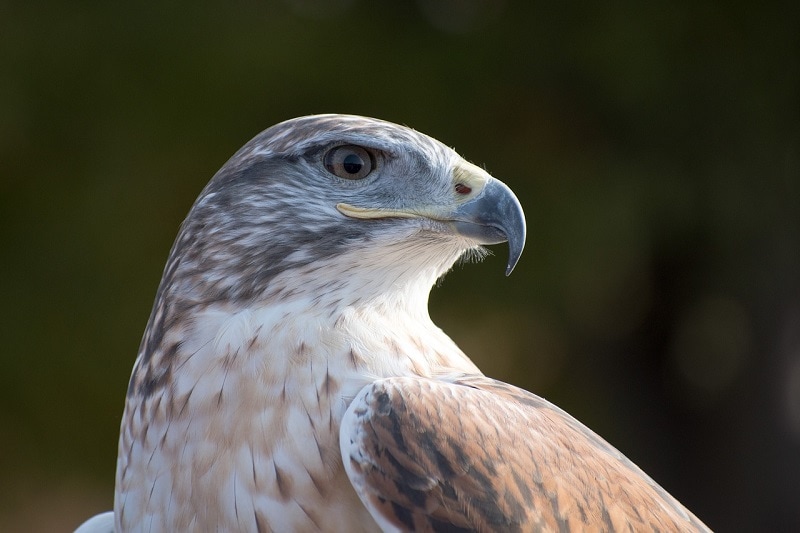
If you’ve never been to Arizona, it’s easy to write the area off as a desert wasteland filled with cactus and sweltering with heat. To some degree, that’s true; at least the parts about the sweltering heat and cactus. However, the deserts of Arizona are anything but wasteland. The state holds a rich diversity of wildlife and many different environments from deserts to lush paradises and everything between.
You’ll find thousands of wildlife species in the state of Arizona, including a wide range of predators. While the state has many landbound predators, such as coyotes, bears, bobcats, and mountain lions, we’re going to focus on a different type of creature entirely. With members of the family reaching speeds of up to 120 miles per hour, these winged predators are some of the fastest creatures in the state and are known for often scooping small pets from unsuspecting backyards. These are the 16 hawk species known to inhabit Arizona.

1. Broad-Winged Hawk
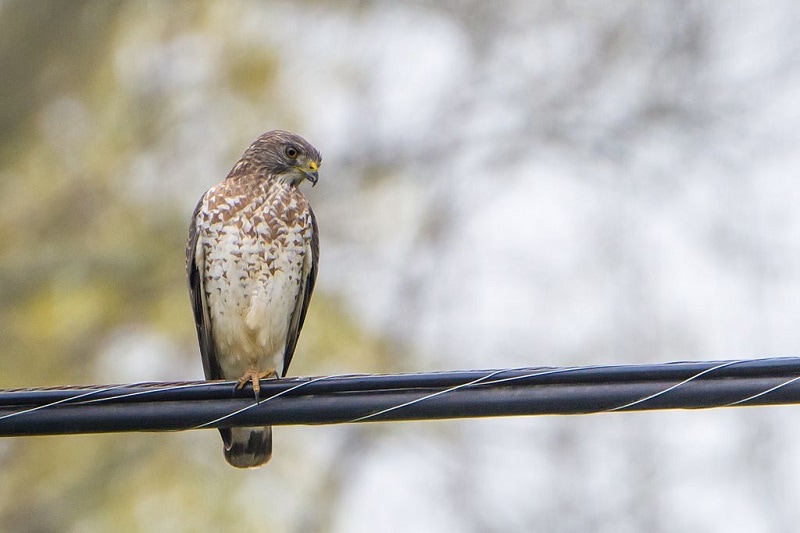
This species of hawk is so-named for its broad, short wings, which are pointed at the ends. These wings are unique to the Broad-Winged Hawk and won’t be seen on other hawk species. They’re medium-sized migratory birds with a wingspan that can range from 29-39 inches. You’ll find these hawks all across North America, so they’re not special to Arizona. They don’t occupy much of the state, but there is an area west of the Grand Canyon that’s part of their migration range and you can see them there at specific times of the year.
2. Common Black Hawk
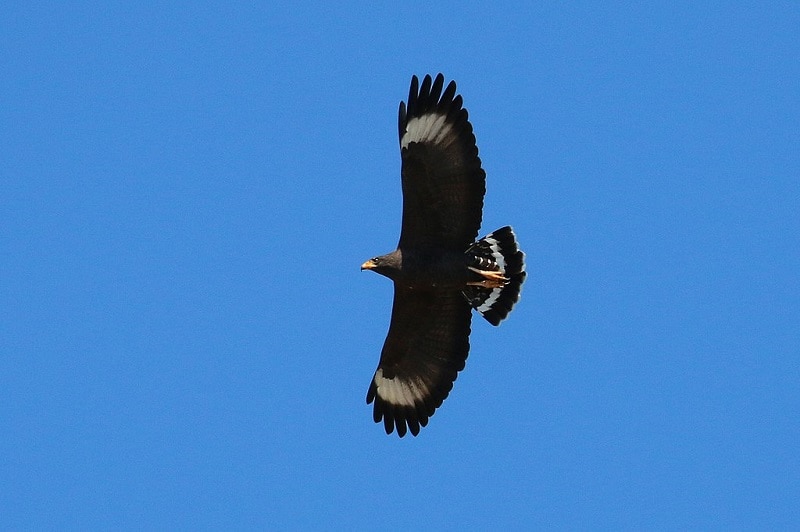
Similar in appearance to Zone-Tailed Hawks, Common Black Hawks are rather large with feathers of dark gray or black. They have short tails that are tipped with white and feature a single broad white band. These birds are rather large, weighing in just shy of two pounds and displaying wingspans of about 50 inches on average. There’s a sizable migratory population of these hawks in the north-western part of the state.
3. Cooper’s Hawk
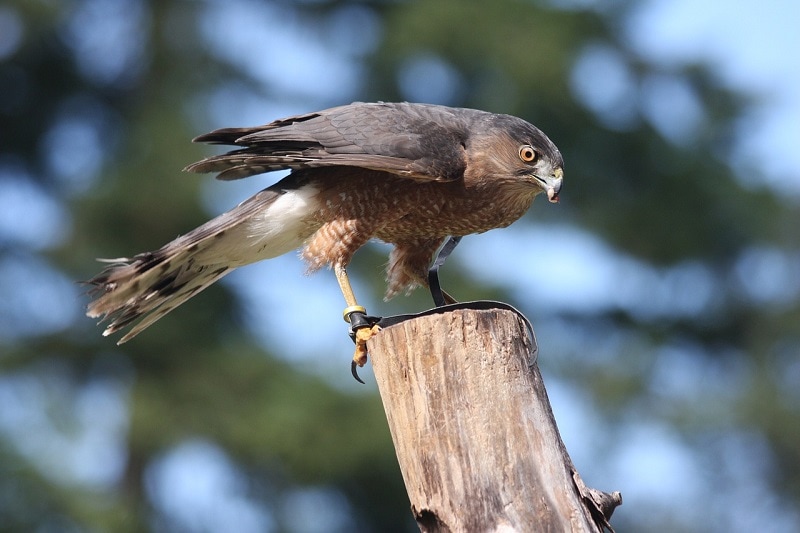
You can find Cooper’s Hawk specimens all across the North American continent, spanning from Mexico up to southern Canada. They’re a bit small compared to many of the other hawks found in Arizona, ranging 14-18 inches in length on average with wingspans that can be anywhere from 24-39 inches. Females are generally about 20% larger and 40% heavier than males. Other common names for the Cooper’s Hawk include big blue darter, hen hawk, quail hawk, chicken hawk, swift hawk, and striker.
4. Ferruginous Hawk

Part of the Buteo Hawk family, the Ferruginous Hawk is a large raptor with rust-colored feathers on its wings and a white belly. They were once called Ferrugineous Rough-Leg Hawks because they appear so similar to the Rough-Legged Hawk, which they’re closely related to. These birds are huge, with wingspans ranging from 48-60 inches. They’re generally 20-27 inches in length and females can weigh in at nearly four pounds.
5. Gray Hawk

Another hawk from the Buteo family, the Gray Hawk is also known as the Mexican Goshawk. They’re about 21 inches long on average with a wingspan of approximately 35 inches, making them one of the smaller species in the state. But these birds are quite quick and agile thanks to their shorter wings. They feed mainly on lizards and snakes, though they’ll also eat frogs, small mammals, and even other birds.
6. Harris’s Hawk
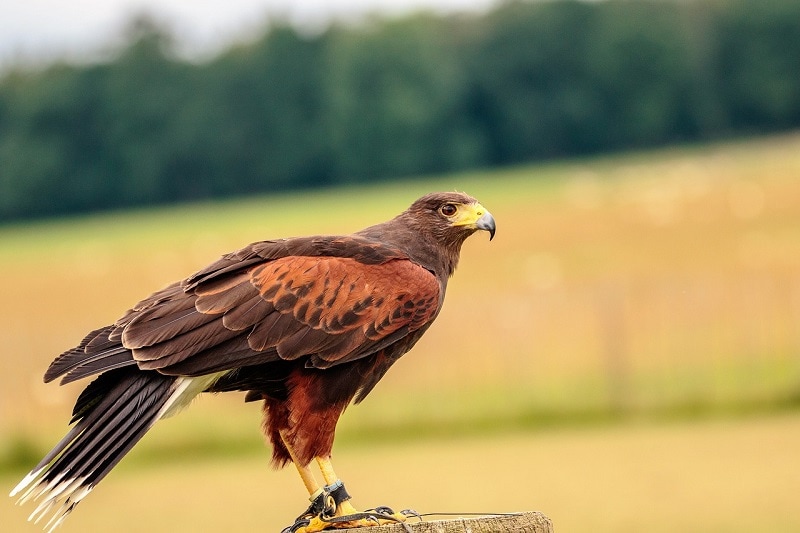
It used to be called the Bay-Winged Hawk or the Dusky Hawk, but this hawk that lives across the Southwestern US, Chile, Argentina, and Brazil is now known as Harris’s Hawk. This species is notable for its ability to hunt in packs cooperatively; in comparison, most raptors hunt alone. Harris’s Hawks are often used in falconry because of their high levels of intelligence and social natures that make them easy to train.
7. Northern Goshawk
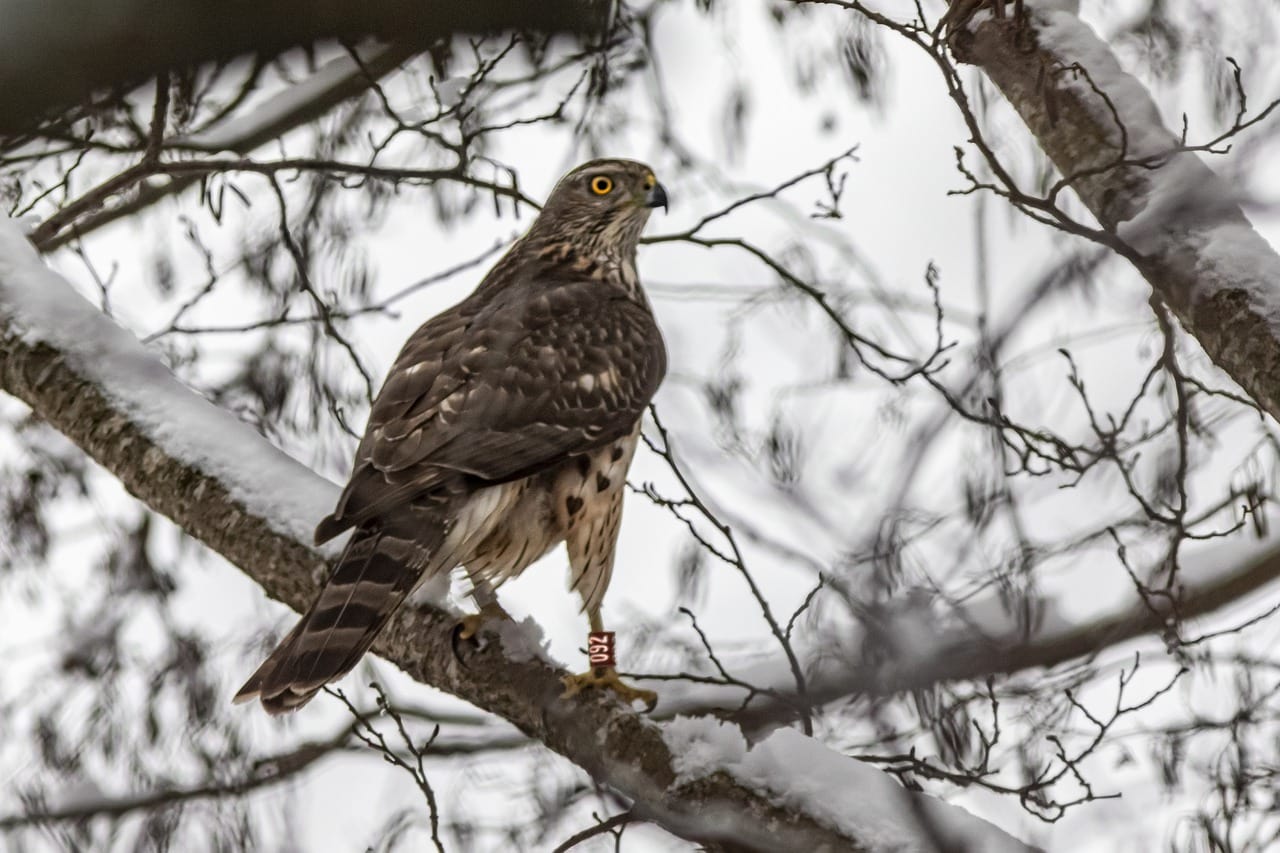
Though not common in Arizona, populations of the Northern Goshawk can be found in the southeastern part of the state, and even in southwestern New Mexico. This species is quite broad-reaching, being found through much of Canada, the Western US, and in most parts of Europe, Russia, Greece, Morocco, Turkey, and more. They’re the only species of hawk that is found in both Eurasia and North America.
8. Red-Shouldered Hawk
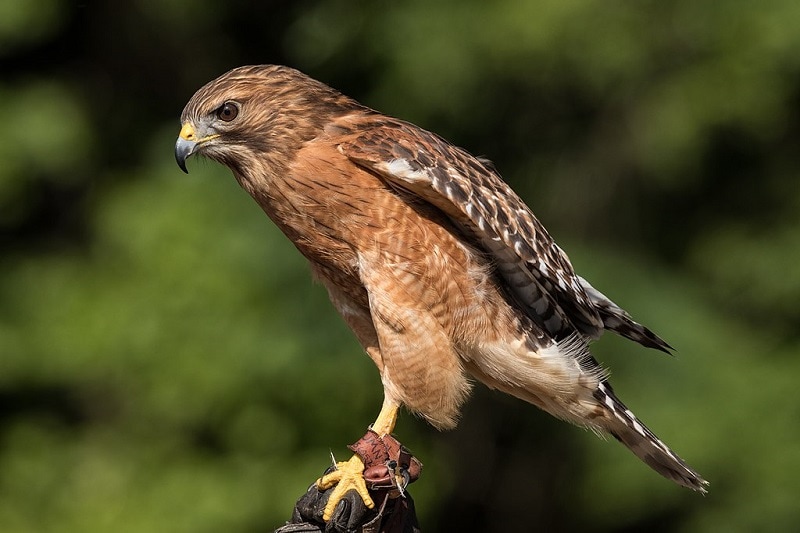
Red-Shouldered Hawks are often at war with Crows and Great Horned Owls, and these hawks have even been known to eat the young of Owls that they attacked, though usually, it’s the owls that do the attacking. There are five different subspecies of Red-Shouldered Hawks found almost exclusively in the United States, though some can occasionally be found in parts of Mexico and Canada as well.
9. Red-Tailed Hawk

The Red-Tailed Hawk is an impressive raptor that’s capable of reaching speeds up to 120 miles per hour. As the name implies, they have red on the top and underside of their tails, making them easy to identify. They’re on the large side of the hawk spectrum with wingspans up to 53 inches in width and often weighing in excess of three pounds.
10. Rough-Legged Hawk
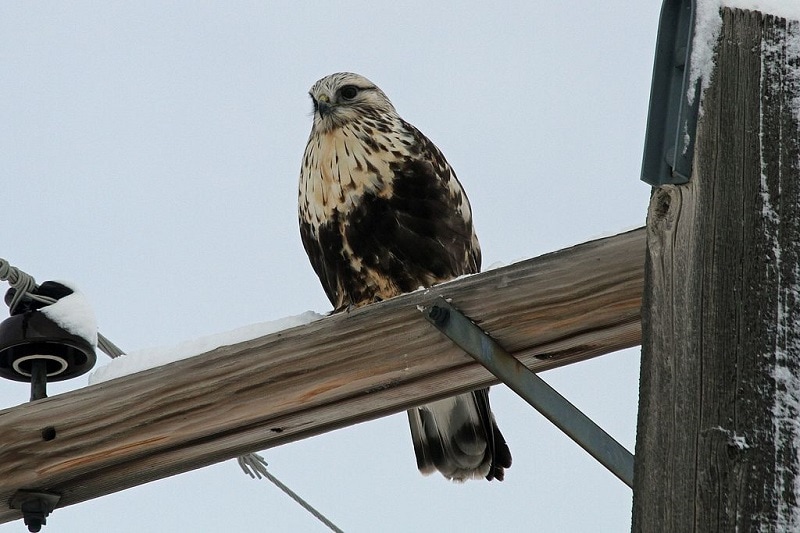
Also known as the Rough-legged Buzzard, the Rough-legged Hawk is a member of Buteo hawk family. You can only find them in Arizona during the winter months when they’ve migrated south from the Arctic and Subarctic North American regions where they usually reside. They’re one of the few birds of prey that regularly hover, aided by their large wings that can span 60 inches. They can weigh more than 3.5 pounds and are generally 18-24 inches in length.
- You might also like: 14 Species Of Hawks in California
11. Sharp-Shinned Hawk

Though not the smallest hawks in the world, male Sharp-shinned Hawks are the smallest hawks you’ll find in Canada or the United States. These hawks are just 9-12 inches in length with short wingspans that are just 20 inches on average. Females are approximately 50% heavier than males. Adult Sharp-shinned Hawks have short but broad wings with tails that can be notched square, rounded, or anything between. They’re found all over North and Central America, including most of Canada, the US, and Mexico. Native populations can also be found in the south-eastern regions of South America.
12. Short-Tailed Hawk

You won’t commonly find Short-tailed Hawks in Arizona, but there are specimens occasionally spotted in the southernmost parts of the state on the edge of the Mexico-Arizona border. Most of its natural territory is in Central America and the northern half of South America, though there are as many as 500 Short-Tailed Hawks living in Florida. They’re rather small hawks at just 15-17 inches long with wingspans that top out at 39 inches, yet their main source of food is other birds, which they capture by dropping down on them from above.
13. Swainson’s Hawk
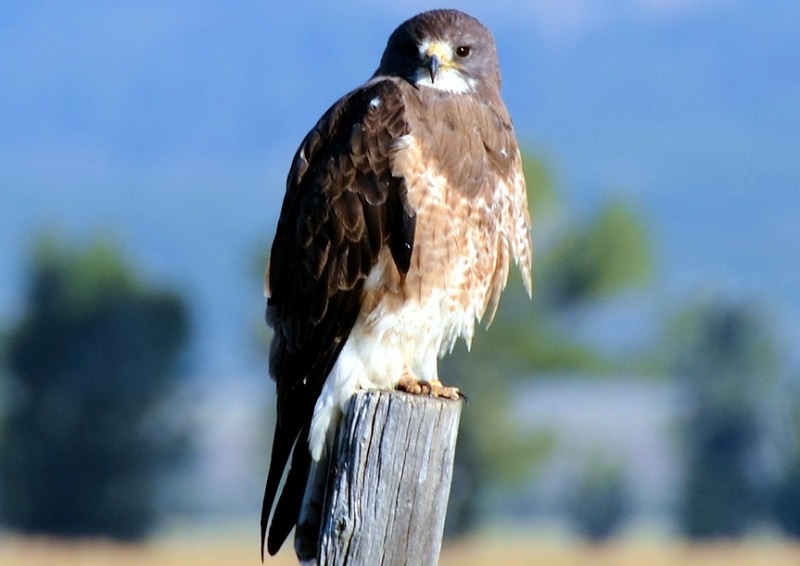
This large species is named after the British naturalist William Swainson, and it sometimes goes by the name of Grasshopper Hawk or Locust Hawk because of their propensity to eat either insect in great number when they’re available. They prefer dry grasslands and prairie regions in the western portion of the US, nesting on cliff edges or in trees and shrubs. Swainson’s Hawks migrate great distances, wintering as far as Argentina, Chile, the Dominican Republic, and even Norway.
14. White-tailed Hawk

Large and stocky, White-Tailed Hawks can reach lengths of 24 inches with wingspans spreading 56 inches across. They can weigh nearly three pounds and have short white tails with a very obvious black band around the end. There are three subspecies of the White-Tailed hawk, of which only one resides in the United States. In America, you’ll find them from coastal Texas through parts of Middle America, though their range also reaches to northern Columbia and western Venezuela.
15. Zone-Tailed Hawk

The Zone-tailed Hawk is sometimes mistaken for a turkey vulture as they have similar plumage and flight styles. These birds are slender, weighing less than 2.5 pounds, though they’re quite large with wingspans up to 55 inches and overall lengths between 18-22 inches when fully grown. They’re mostly black in color, though their flight feathers are barred in a lighter gray. Additionally, their tails have bands of white on the bottom and gray on the top known as zones, which earn the species its name.

Conclusion
Though many of these hawk species are only found in small slivers of Arizona, all of them can be spotted within the state if you look at the right time in the right place. Arizona may not harbor large populations of all 15 of these hawk species, but the good news is that all of them have a conservation status of “least concern.” If you didn’t before, by now, you should realize that Arizona is a diverse region with a wealth of wildlife. After all, more than half of the hawk species that exist in the US can be found in the state, with only 10 remaining species in the country that aren’t.
Check out some of our other top trending birding posts:
- 8 Types of Bird Houses: Which Is Right for You?
- 15 Types of Crane Bird Species in 2021 (With Pictures)
- 15 Bird Documentaries and Movies Worth Watching in 2021
Featured Image Credit: reitz27, Pixabay
Table of Contents
About the Author Dean Eby
An avid outdoorsman, Dean spends much of his time adventuring through the diverse terrain of the southwest United States with his closest companion, his dog, Gohan. He gains experience on a full-time journey of exploration. For Dean, few passions lie closer to his heart than learning. An apt researcher and reader, he loves to investigate interesting topics such as history, economics, relationships, pets, politics, and more.
Related Articles:
Monocular vs Telescope: Differences Explained (With Pictures)
How to Clean a Refractor Telescope: Step-by-Step Guide
How to Clean a Telescope Eyepiece: Step-by-Step Guide
How to Clean a Rifle Scope: 8 Expert Tips
What Is a Monocular Used For? 8 Common Functions
How to Clean a Telescope Mirror: 8 Expert Tips
Brightfield vs Phase Contrast Microscopy: The Differences Explained
SkyCamHD Drone Review: Pros, Cons, FAQ, & Verdict
